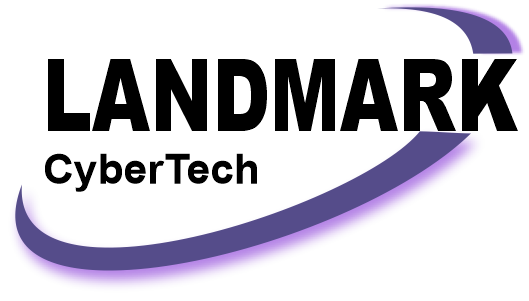Training Programs
- Home Page
- Training Programs
Take the LEAP; Change Your Career, Change Your Life!
Seize this opportunity to make a difference and secure your future.
Join the forefront of safeguarding our digital world! As cyber threats evolve, the demand for skilled defenders grows. At Landmark CyberTech, we’re empowering individuals like you to launch rewarding careers in the world of ever-evolving cybersecurity landscape, regardless of your background.

Why Choose Landmark CyberTech?
- Hands-on Learning: We focus on "learning by doing," immersing participants in a real-world work environment.
- Industry-Focused Curriculum: Our program is designed around employer and industry needs, ensuring you gain the skills most sought after in the cybersecurity job market.
- Comprehensive Support: From resume building to job interview preparation, we provide continuous support, even after the training is over.
- Career-Ready: Our curriculum aligns with the key factor’s enterprises consider when hiring for cybersecurity positions:
Practical Skill Competency
Certification Attainment
Technical Skills
Program Highlights
- Date: Saturday, August 2 - Tuesday, October 28, 2025
- Format: Instructor-led, with real-world projects and hands-on labs
- Schedule: Tuesdays (7 PM - 9 PM EST) & Saturdays (10 AM - 3 PM EST)
- Target Audience: Anyone seeking a career in cybersecurity, including those from non-IT backgrounds
Job Outlook: Your Future in Cybersecurity
- High Demand: Cybersecurity professionals are in high demand, with job prospects far exceeding the supply.
- Projected Growth: The employment of Information Security Analysts is projected to grow 32% from 2018 to 2028—much faster than the average for all occupations.
- Global Opportunities: Cybersecurity Ventures predicts 3.5 million unfilled cybersecurity jobs globally by 2025.
- Open to All: The field is open to both recent graduates and those looking to make a career change.
Prepare for Your Cybersecurity Journey: Essential Resources and Insights
PDF Documents
Recommended Videos
Curriculum

Module 1: Cybersecurity Fundamentals
Duration: August 2 – 30, 2025
Schedule: Tuesdays (7PM – 9PM EST) & Saturdays (10AM – 3PM EST)
Curse Description:
This module introduces participants to the foundational principles and practices of cybersecurity. It equips students with the knowledge and skills necessary to protect information systems, identify vulnerabilities, and respond to cybersecurity threats. By integrating theoretical knowledge with practical applications, participants will gain a robust understanding of the cybersecurity landscape and its importance in safeguarding digital assets.
Learning Objectives:
- Comprehend the principles and core concepts of cybersecurity.
- Understand and analyze common cyber threats, vulnerabilities, and risks.
- Develop skills in network security, system defense mechanisms, and secure design principles.
- Explore the fundamentals of identity and access management, and data protection strategies.
- Apply knowledge through hands-on labs and case studies to reinforce learning.
Topics Covered:
1. Introduction to Cybersecurity
- Overview of cybersecurity concepts, terminology, and key principles.
- Importance of cybersecurity in the modern digital landscape.
2. Cybersecurity Threats and Vulnerabilities
- Exploration of threats like malware, ransomware, phishing, and social engineering.
- Understanding vulnerabilities in software, hardware, and human factors.
3. Foundations of Information Security
- Core principles: Confidentiality, Integrity, and Availability (CIA Triad).
- Additional principles: Authentication, Authorization, Non-repudiation, and Accountability.
4. Network Security Basics
- Introduction to networking concepts and components: routers, firewalls, intrusion detection systems (IDS), and switches.
- Understanding network vulnerabilities and securing communication channels.
5. Identity and Access Management (IAM)
- Overview of identity management principles and practices.
- Implementation of least privilege, multi-factor authentication (MFA), and identity governance.
6. Risk and Vulnerability Management
- The risk equation: Risk = Threat x Vulnerability.
- Identifying, assessing, and managing risks to minimize cybersecurity impacts.
7. Security Protocols and Encryption
- Basics of encryption methods and their role in secure communication.
- Exploring security protocols like HTTPS, SSL/TLS, and VPNs.
Outcomes for Participants
- Develop foundational cybersecurity expertise applicable across industries.
- Gain hands-on experience through interactive labs and real-world case studies.
- Build confidence in mitigating cyber risks and securing information systems.
This module sets the stage for advanced cybersecurity learning, preparing participants for the challenges of securing digital environments in the modern era.
Module 2: Governance, Risk, and Compliance (GRC)
Duration: September 2 – October 28, 2025
Schedule: Tuesdays (7 PM – 9 PM EST) & Saturdays (10 AM – 3 PM EST)
Course Description:
This advanced module provides a deep dive into governance, risk management, and compliance (GRC) in cybersecurity. Participants will learn to navigate complex compliance landscapes, manage risks effectively, and maintain system documentation. This module also prepares participants for the Certified Governance, Risk, and Compliance (CGRC) Certification Exam.
Learning Objectives:
- Understand the fundamentals of information security and privacy governance.
- Master risk management processes, including identification, analysis, and mitigation.
- Navigate and apply various compliance regulations in real-world scenarios.
- Develop skills for achieving and maintaining Authorization to Operate (ATO).
- Implement and assess security and privacy controls.
- Prepare for and conduct effective IT audits using ISO 27001.
- Manage third-party risks and their impact on organizational security.
Topics Covered:
1. Governance Fundamentals
- Overview of Information Security and Privacy Governance: Explore the importance of governance in information security, focusing on establishing a comprehensive governance, risk management, and compliance program.
- Policies and Procedures: Learn how to develop and implement effective security and privacy policies.
- Risk Management Frameworks: Introduction to frameworks such as NIST RMF and ISO 27001.
2. Risk Management in Action
- Risk Identification: Techniques for identifying potential security and privacy risks.
- Risk Analysis: Methods for analyzing the impact and likelihood of identified risks.
- Risk Mitigation: Explore strategies to reduce, transfer, accept, or avoid risks.
- Hands-on Labs: Practical exercises in risk assessment and management using real-world scenarios.
3. Compliance Landscape
- Navigating Compliance Regulations: In-depth look at key regulations such as NIST, FISMA, HIPAA, PCI DSS, ISO 27001, and GDPR.
- System Compliance: Understand the steps necessary to achieve and maintain system compliance with relevant laws, regulations, and standards.
- Compliance Implementation: Steps for ensuring compliance in various industry sectors.
4. System Documentation Deep Dive
- Scope of the System: Learn how to define the scope of information systems for security and privacy, including identifying key assets and their boundaries.
- Developing Security Documentation: Learn how to create key documents like System Security Plans (SSP), Incident Response Plans (IRP), and more.
- Maintaining Documentation: Best practices for keeping system documentation up to date.
5. Achieving Authorization to Operate (ATO)
- ATO Process Overview: Detailed exploration of the ATO process within the Risk Management Framework (RMF).
- Selection and Approval of Security and Privacy Controls: Explore the process of selecting appropriate controls and gaining management approval.
- Security Posture Assessment: Methods for demonstrating an information system’s security posture.
- Achieving ATO: Steps to attain operational approval and maintain compliance.
- Hands-on Labs: Developing an ATO package, including security plans and assessment reports.
6. Continuous Monitoring & Vulnerability Management
- Continuous Monitoring: Implementing strategies to continuously monitor for security threats.
- Vulnerability Management: Identify, assess, and mitigate vulnerabilities in real-time.
- Compliance Maintenance: Explore methods for maintaining ongoing compliance, including periodic reviews and updates to security and privacy controls.
7. Understanding ISO 27001 for Risk Assessment
- ISO 27001 Overview: Comprehensive understanding of ISO 27001 and its role in risk assessment.
- Conducting Effective IT Audits: Learn how to conduct IT audits in compliance with ISO 27001 standards.
- Managing Third-Party Risks: Strategies for assessing and managing risks associated with third-party vendors and partners.
8. Workforce-Focused Projects & Professional Development
- Capstone Projects: Apply knowledge to real-world GRC projects.
- Resume Building & Job Search Guidance: Tailored career services to prepare for the cybersecurity job market.

Enrollment Procedures
- Apply Online: Visit www.landmarkcybertech.com to access the application form.
- Submit Required Documents: Provide a completed registration form and payment details.
- Receive Confirmation: Enrollment confirmation and pre-class materials will be sent via email.
- Payment Plan is available: To make our comprehensive cybersecurity training accessible, we offer flexible payment plans to fit your budget.
Additional Features
- Capstone Projects: Hands-on experience solving real-world cybersecurity challenges.
- Certification Preparation: Training aligns with certifications like CompTIA Security+, CGRC, and CISM.
- Career Support: Resume workshops, mock interviews, and job placement assistance.
- Continuous Alumni Support: Mentorship and access to exclusive industry resources post-training.

